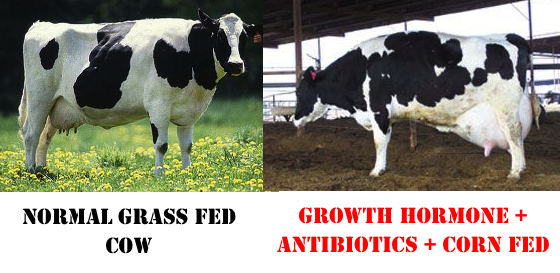Today's post is a continuation of
Today you can go into just about any grocery store and find organic produce and other food items. Buying organic foods does offer health benefits, but do we really know what the label "organic" means? I have found it quite confusing so together let's see if we can't get a better understanding here.
Food that is labeled "organic" is certified by the United States Department of Agriculture (USDA). To use that label the food must have been produced by processes that don't use synthetic fertilizers, irradiation, sewage sludge and genetic engineering - GMO (an important aspect we'll talk about in another post). If produce is not clearly labeled "organic" look for a PLU (price look-up) code that begins with the number "9" which identifies that food as organic.
Buying organic foods helps limit our intake of pesticides, antibiotics, hormones, and other harmful chemicals. By limiting our intake of these substances we place significantly less stress on our detoxification and immune systems which are already challenged by environmental toxins that we can do little about.
I've seen some foods labeled "100% Organic" and some that say "Contains Organic Ingredients" (or something to that effect). What's that all about?
"100% Organic" refers to food that was produced without using synthetic pesticides, petroleum, or sewage/sludge based fertilizers, ionizing radiation (irradiation), or bioengineering as mentioned above.
Choosing meat, poultry, eggs and dairy products with this distinction means the animal was fed 100% organic feed and given no unnecessary antibiotics or growth hormones. For other foods it means that at least 95% of the ingredients are organically produced and the food does not contain sulfites (a substance that can be dangerous to those sensitive to it).
"Made with organic ingredients" means at least 70% of that foods ingredients are organic.
There are other voluntary labels that can be used, but I think we've got a lot to digest here already so I'll save that info for another time.
Before we go though I've got one last thing to share on this topic. When I first started looking to purchase organic produce I experienced sticker shock. It can be very expensive and if you're trying to feed a family it can be prohibitive.
One way to deal with this is to refer to the Environmental Working Group's
Hopefully you can now begin to see why choosing organic will be good for you, and for your family's health, and hopefully you have a better understanding of what "organic" means.
If you'd like to learn more about how you can adopt a Clean Eating Lifestyle for yourself, you can contact me, Stephanie Lee, by phone or text at 760-712-7232, email me at lmt4me.sl@gmail.com, or check out my Facebook page at www.Facebook.com/HealthyWon.
Clean Eating 101: What it means to eat clean
Going OrganicToday you can go into just about any grocery store and find organic produce and other food items. Buying organic foods does offer health benefits, but do we really know what the label "organic" means? I have found it quite confusing so together let's see if we can't get a better understanding here.
Food that is labeled "organic" is certified by the United States Department of Agriculture (USDA). To use that label the food must have been produced by processes that don't use synthetic fertilizers, irradiation, sewage sludge and genetic engineering - GMO (an important aspect we'll talk about in another post). If produce is not clearly labeled "organic" look for a PLU (price look-up) code that begins with the number "9" which identifies that food as organic.
Buying organic foods helps limit our intake of pesticides, antibiotics, hormones, and other harmful chemicals. By limiting our intake of these substances we place significantly less stress on our detoxification and immune systems which are already challenged by environmental toxins that we can do little about.
I've seen some foods labeled "100% Organic" and some that say "Contains Organic Ingredients" (or something to that effect). What's that all about?
"100% Organic" refers to food that was produced without using synthetic pesticides, petroleum, or sewage/sludge based fertilizers, ionizing radiation (irradiation), or bioengineering as mentioned above.
Choosing meat, poultry, eggs and dairy products with this distinction means the animal was fed 100% organic feed and given no unnecessary antibiotics or growth hormones. For other foods it means that at least 95% of the ingredients are organically produced and the food does not contain sulfites (a substance that can be dangerous to those sensitive to it).
"Made with organic ingredients" means at least 70% of that foods ingredients are organic.
There are other voluntary labels that can be used, but I think we've got a lot to digest here already so I'll save that info for another time.
Before we go though I've got one last thing to share on this topic. When I first started looking to purchase organic produce I experienced sticker shock. It can be very expensive and if you're trying to feed a family it can be prohibitive.
One way to deal with this is to refer to the Environmental Working Group's
lists called the Clean Fifteen and the Dirty Dozen. These lists identify produce that have the highest concentration of harmful substances (Dirty Dozen) and the least (Clean Fifteen) so you can choose some non-organic if you're trying to save money. Here's the link to their site: www.ewg.org.
Hopefully you can now begin to see why choosing organic will be good for you, and for your family's health, and hopefully you have a better understanding of what "organic" means.
If you'd like to learn more about how you can adopt a Clean Eating Lifestyle for yourself, you can contact me, Stephanie Lee, by phone or text at 760-712-7232, email me at lmt4me.sl@gmail.com, or check out my Facebook page at www.Facebook.com/HealthyWon.







No comments:
Post a Comment